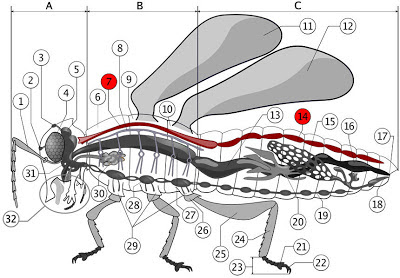Unlocking the Secrets of Insect Breathing

Ever wonder how that tiny ant carries many times its weight or how a buzzing bee manages such impressive aerial feats? The secret lies, in part, within their remarkably efficient breathing mechanisms. Insects don't breathe like we do. They've evolved a completely different system, perfectly suited to their small size and active lifestyles. This system, known as the insect respiratory system, is a marvel of natural engineering.
Unlike our lungs, which rely on blood to transport oxygen, insects use a network of tubes called tracheae to deliver oxygen directly to their tissues. These tracheae, branching throughout their bodies like miniature air ducts, open to the outside through tiny pores called spiracles. This direct delivery system allows insects to obtain the oxygen they need for their energy-intensive activities.
The evolutionary history of insect breathing is closely tied to their colonization of land. As insects moved from water to land, they needed a way to access oxygen from the air. The tracheal system evolved to meet this challenge, providing a highly efficient means of gas exchange in a terrestrial environment. This adaptation was crucial to the incredible diversification and success of insects, allowing them to thrive in virtually every habitat on Earth.
The importance of the insect respiratory system can't be overstated. It's the engine that powers their movement, flight, and all other bodily functions. A malfunctioning respiratory system can be detrimental to an insect's survival. Environmental factors, such as pollutants and pesticides, can interfere with the delicate balance of gas exchange, impacting insect populations.
Understanding insect respiration is crucial for various fields, from pest control to understanding broader ecological processes. For instance, some insecticides target the insect respiratory system, disrupting its function and leading to their demise. Furthermore, the study of insect respiration provides valuable insights into the evolution of respiratory systems in other animals.
The insect respiratory system functions through a combination of passive diffusion and active ventilation. Smaller insects rely primarily on passive diffusion, where oxygen moves from an area of high concentration (outside air) to an area of low concentration (inside the insect's tissues). Larger, more active insects, however, may actively pump air in and out of their tracheal system through muscular contractions, increasing the efficiency of gas exchange.
One benefit of the insect respiratory system is its efficiency in delivering oxygen directly to tissues. This bypasses the circulatory system, allowing for rapid energy production. Another advantage is its adaptability. Some aquatic insects have modified spiracles and tracheae for extracting oxygen from water, while others carry air bubbles with them for diving. Finally, the tracheal system is lightweight, a significant advantage for flight.
Several factors influence insect respiration rates. Temperature, activity level, and metabolic needs all play a role. Insects are ectothermic, meaning their body temperature is regulated by the environment. Higher temperatures generally lead to increased respiration rates.
Scientists study insect respiration using various techniques, including respirometry, which measures the rate of oxygen consumption. Microscopic examination of tracheae and spiracles provides detailed insights into their structure and function.
Advantages and Disadvantages of the Insect Respiratory System
| Advantages | Disadvantages |
|---|---|
| Efficient oxygen delivery | Susceptible to desiccation (water loss) |
| Lightweight | Limits body size |
| Adaptable to various environments | Vulnerable to respiratory toxins |
Frequently Asked Questions about Insect Respiration:
1. How do insects breathe? Through a network of tubes called tracheae.
2. What are spiracles? Tiny pores on the insect's body that open to the tracheae.
3. Do all insects breathe the same way? While the basic principle is the same, there are variations depending on the insect's size, habitat, and activity level.
4. How does the insect respiratory system differ from the human respiratory system? Insects deliver oxygen directly to tissues, while humans use blood as a transport medium.
5. What are some challenges to the insect respiratory system? Desiccation, limited body size, and vulnerability to toxins.
6. How does temperature affect insect respiration? Higher temperatures increase respiration rates.
7. How do scientists study insect respiration? Through techniques like respirometry and microscopic examination.
8. Why is understanding insect respiration important? It helps us understand insect physiology, ecology, and develop effective pest control strategies.
In conclusion, the insect respiratory system, with its network of tracheae and spiracles, is a remarkable example of evolutionary adaptation. Its direct oxygen delivery system supports the high energy demands of insects, enabling their incredible diversity and success. Understanding this intricate system provides valuable insights into the biology of insects and their interactions with the environment. From pest control to ecological studies, the study of insect breathing continues to unveil important information about these fascinating creatures. Further exploration of this field is crucial for developing sustainable pest management strategies and understanding the broader implications of environmental changes on insect populations. By delving deeper into the intricacies of insect respiration, we can gain a greater appreciation for the remarkable adaptations that have allowed insects to thrive in virtually every corner of the globe.
Tiktok aesthetic backdrops level up your videos
Raised by villains novel updates your guide to the latest chapters
Nfl expert picks this week analysis





:max_bytes(150000):strip_icc()/respiratorysystem-56a51ed73df78cf7728654fa.jpg)







